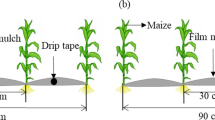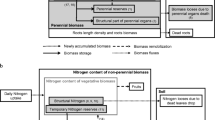Abstract
Many crop models relate the allocation of dry matter between shoots and roots exclusively to the crop development stage. Such models may not take into account the effects of changes in environment on allocation, unless the allocation parameters are altered. In this paper a crop model with a dynamic allocation parameter for dry matter between shoots and roots is described. The basis of the model is that a plant allocates dry matter such that its growth is maximized. Consequently, the demand and supply of carbon, nitrogen, and water is maintained in balance. This model supports the hypothesis that a functional equilibrium exists between shoots and roots.
This paper explains the mathematical computation procedure of the crop model. Moreover, an analysis was made of the ability of a crop model to simulate plant dry matter production and allocation of dry matter between plant organs. The model was tested using data from a greenhouse experiment in which spring wheat (Triticum aestivum L.) was grown under different soil moisture and nitrogen (N) levels.
Generally, the model simulations agreed well with data recorded for total plant dry matter. For validation data the coefficient of determination (r2) between simulated and measured shoot dry weight was 0.96. For the validation treatments r2 was slightly lower, 0.94. In addition to dry matter production the model succeeded satisfactorily in simulating the dry weight of different plant organs. The response of simulated root to shoot ratio to the level of soil moisture was mainly in accordance with the measured data. In contrast, the simulated ratio seemed to be insensitive to the changes in the levels soil N concentration used in the experiment.
The data used in the present study were not extensive, and more data are needed to validate the model. However, the results showed that the model responses to the changes in soil N and water level were realistic and mostly agreed with the data. Thus, we suggest that the model and the method employed to allocate dry matter between roots and shoots are useful when modelling the growth of crops under N and water limited conditions.
Similar content being viewed by others
References
Allen R G, Jensen M E, Wright J L and Burman R D 1989 Operational estimates of reference evapotranspiration. Agron. J. 81, 650–662.
Angus J F and Moncur M W 1977 Water stress and phenology in wheat. Aust. J. Agric. Res. 28, 177–181.
Aslyng H C and Hansen S 1982 Water balance and crop production simulation. Hydrotechnical Laborotory, The Royal Veterinary and Agricultural University, Copenhagen, Denmark. 200 p.
Brouwer R 1962a Distribution of dry matter in the plant. Neth. J. Agric. Sci. 10, 361–376.
Brouwer R 1962b Nutritive influences on the distribution of dry matter in the plant. Neth. J. Agric. Sci. 10, 399–408.
Campbell C A, Davidson H R and McCaig T N 1983 Disposition of nitrogen and soluble sugars in Manitou spring wheat as influenced by N fertilizer, temperature, and duration and stage of moisture stress. Can. J. Plant Sci. 63, 73–90.
Chanter D O 1976 Mathematical models in mushroom research and production. D. Phil. Thesis, University of Sussex, USA.
Clarke A L and Barley K P 1968 The uptake of nitrogen from soils in relation to solute diffusion. Aust. J. Soil Res. 6, 75–92.
Clarkson D T 1985 Factors affecting mineral nutrient acquisition by plants. Annu. Rev. Plant Physiol. 36, 77–115.
Erpenbeck J M 1981 A methodology to estimate crop water requirements in Washington State. M.Sc. thesis, Washington State University, Pullman, USA.
Feddes R A, Kowalik P J and Zaradny H 1978 Simulation of water use and crop yield. Pudoc, Wageningen, the Netherlands. 189 p.
France J and Tholnley J H M 1984 Mathematical Models in Agriculture, Butterworth and Co Ltd, London, UK.
Franck A B, Bauer A and Black A L 1992 Effects of air temperature and fertilizer nitrogen on spike development in spring barley. Crop Sci. 32, 793–797.
Greenwood D J, Wood J T and Cleaver T J 1974 A dynamic model for the effects of soil and weather conditions on nitrogen response. J. Agric. Sci., Camb. 82, 455–467.
Goudriaan J 1986 A simple and fast numerical method for the computation of daily totals of crop photosynthesis. Agric. For. Meteor. 38, 249–254.
Groot J R R, de Willigen P and Verberne E L J 1991 Nitrogen turnover in the soil-crop system. Fert. Res. 27.
Hodges T and French V 1985 Soybean phenology model based on temperature, daylength, and water stress. Agron. J. 77, 500–505.
Karvonen T and Kleemola J 1995 CROPWATN: Prediction of water and nitrogen limited crop production.In Modelling and Parametrizition of the Soil-plant-atmosphere System: A comparison of Potato Growth Models. Eds. B Kabat, B J van den Broek, B Marshall, J Vos and H van Keulen. pp 335–370. Wageningen Pers, Wageningen, the Netherlands.
Kleemola J 1991 Effect of temperature on phasic development of spring wheat in northern conditions. Acta Agric. Scand. 41, 275–283.
Nelder J A and Mead R 1965 An iterative method of finding stationary values of a function of several variables. Computer J. 5, 147–151.
O'Neill R 1971 Algorithm AS 47. Function minimizing using a simplex procedure. Appl. Statist. 20, 338–345.
Peltonen J 1993 Grain yield of high- and low-protein wheat cultivars as influenced by timing of nitrogen application during generative development. Field Crops Res. 33, 385–397.
Penning de Vries F W T, Witlage J M and Kremer D 1979 Rates of respiration and of increase in structural dry matter in young wheat, ryegrass and maize plants in relation to temperature, to water stress and to their sugar content. Ann. Bot. 44, 595–609.
Pilbeam D J and Kirkby E A 1990 The physiology of nitrate uptake.In Nitrogen in higher Plants. Ed. Y P Abrol. pp 39–64. Research Studies Press Ltd., Taunton, UK.
Reynolds J F and Thornley J H M 1982 A shoot:root partitioning model. Ann. Bot. 49, 585–597.
Ritchie J T 1972 Model for predicting evapotranspiration from a row crop with incomplete cover. Water Resour. Res. 8, 1208–1213.
Schulze E D 1983 Root-shoot interactions and plant life forms. Neth. J. Agric. Sci. 31, 291–303.
Schulze E D, Schilling K and Nagarajah S 1983 Carbohydrate partitioning in relation to whole plant production and water use ofVigna unguiculata (L.). Oecologia 58, 169–177.
Spitters C J T 1986 Separating the diffuse and direct component of global radiation and its implications for modelling canopy photosynthesis. Part II: Calculation of canopy photosynthesis. Agric. For. Meteor. 38, 231–242.
Spitters C J T, Toussaint H A J M and Goudriaan J 1986 Separating the diffuse and direct component of global radiation and its implications for modelling canopy photosynthesis. Part I: Components of incoming radiation. Agric. For. Meteor. 38, 217–229.
Teittinen M, Karvonen T and Peltonen J 1994 A dynamic model for water and nitrogen limited growth in spring wheat to predict yield and quality. J. Agric. Crop Sci. 172, 90–103.
Tetens O 1930 Über einige meteorologische Begriffe. Z. Geophys. 6, 297–309.
Thornley J H M 1972 A balanced quantitative model for root:shoot ratios in vegetative plants. Ann. Bot. 36, 431–441.
Van Keulen H and Seligman N G 1987 Simulation of Water Use, Nitrogen Nutrition and Growth of a Spring Wheat Crop. Pudoc, Wageningen, the Netherlands. 310 p.
Van der Werf A, Visser A J, Schieving F and Lambers H 1993 Evidence for optimal partitioning of biomass and nitrogen at a range of nitrogen availabilities for a fast- and slow-growing species. Funct. Ecol. 7, 63–74.
Author information
Authors and Affiliations
Rights and permissions
About this article
Cite this article
Kleemola, J., Teittinen, M. & Karvonen, T. Modelling crop growth and biomass partitioning to shoots and roots in relation to nitrogen and water availability, using a maximization principle. Plant Soil 185, 99–111 (1996). https://doi.org/10.1007/BF02257567
Received:
Accepted:
Issue Date:
DOI: https://doi.org/10.1007/BF02257567




